Related Research Articles

Oxford is a town in Worcester County, Massachusetts, United States. The population was 13,347 as of the 2020 United States Census.

Webster is a town in Worcester County, Massachusetts, United States. The population was 17,776 at the 2020 census.
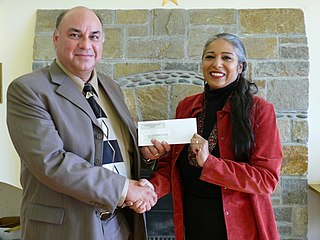
The Wampanoag, also rendered Wôpanâak, are a Native American people of the Northeastern Woodlands currently based in southeastern Massachusetts and formerly parts of eastern Rhode Island. Their historical territory includes the islands of Martha's Vineyard and Nantucket.
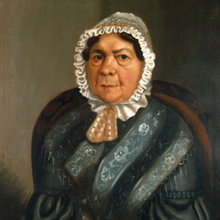
The Nipmuc or Nipmuck people are an Indigenous people of the Northeastern Woodlands, who historically spoke an Eastern Algonquian language. Their historic territory Nippenet, meaning 'the freshwater pond place', is in central Massachusetts and nearby parts of Connecticut and Rhode Island.
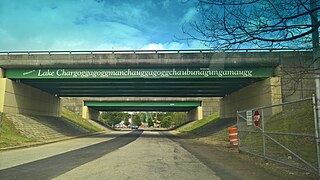
Lake Chaubunagungamaug, also known as Webster Lake, is a lake in the town of Webster, Massachusetts. It is located near the Connecticut border and has a surface area of 1,442 acres. Since 1921, the lake has also been known by a much longer name having 45 letters comprising fourteen syllables: Lake Chargoggagoggmanchauggagoggchaubunagungamaugg. The lake has become famous beyond Central Massachusetts for having the longest name of any geographic feature in all of the United States.
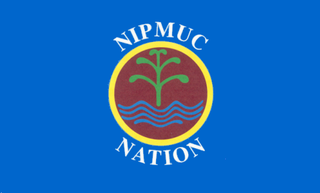
The Nipmuc Nation was a non profit entity of the state-recognized tribe Hassanamisco Nipmuc, an Indigenous people of the Northeastern Woodlands based in South Grafton, Massachusetts.

Praying towns were settlements established by English colonial governments in New England from 1646 to 1675 in an effort to convert local Native Americans to Christianity.

The Hassanamisco Nipmuc Band is the sole state-recognized tribe in the Commonwealth of Massachusetts. They were recognized in 1976 by Governor Michael Dukakis via Executive Order 126. They were briefly known as the Nipmuc Nation, a union of the Hassanamisco Nipmuc and the Chaubunagungamaug Nipmuck bands, during their attempt to receive federal acknowledgment as a Nation. The Hassanamisco Nipmuc Band owns three and a half acres of reservation land in what is present day Grafton, Massachusetts. The Nipmuc are native to Central Massachusetts, Northeastern Connecticut, and parts of Rhode Island.
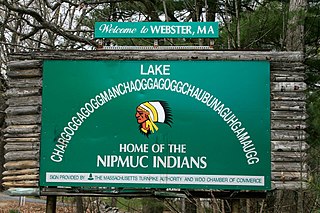
The Webster/Dudley Band of Chaubunagungamaug Nipmuck Indians, also known as the Chaubunagungamaug, Chaubunagungamaug Nipmuck, Pegan or Dudley/Webster Indians, is a cultural heritage group that claims descent from the Nipmuc people. They are an unrecognized tribe, meaning they are neither federally recognized nor state-recognized, unlike the Hassanamisco Nipmuc Band.

The Chaubunagungamaug Reservation refers to the small parcel of land located in the town of Thompson, Connecticut, close to the border with the town of Webster, Massachusetts, and within the bounds of Lake Chaubunagungamaug to the east and the French River to the west. The reservation is used by the descendants of the Nipmuck Indians of the previous reservation, c. 1682–1869, that existed in the same area, who now identify as the Webster/Dudley Band of the Chaubunagungamaug Nipmuck.
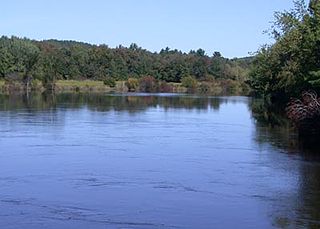
The Nashaway were a tribe of Algonquian Indians inhabiting the upstream portions of the Nashua River valley in what is now the northern half of Worcester County, Massachusetts, mainly in the vicinity of Sterling, Lancaster and other towns near Mount Wachusett, as well as southern New Hampshire. The meaning of Nashaway is "between," an adverbial form derived from "nashau" meaning "someone is between/in the middle" = adverbial suffix "we" Gustafson, Holly (2000), "A Grammar of the Nipmuc Language," University of Manitoba.</ref>

The Battle of Turner's Falls or Battle of Grand Falls; also known as the Peskeompscut-Wissantinnewag Massacre, was a battle and massacre occurring on May 19, 1676, in the context of King Philip's War in what is present-day Gill and Greenfield, across from Turners Falls on the Connecticut River. The incident marked a turning point in the war, and in the colonization of Native lands by British settlers. The war led to the expulsion of most Native Americans in the Connecticut River Valley.
The Massachusett dialects, as well as all the Southern New England Algonquian (SNEA) languages, could be dialects of a common SNEA language just as Danish, Swedish and Norwegian are mutually intelligible languages that essentially exist in a dialect continuum and three national standards. With the exception of Massachusett, which was adopted as the lingua franca of Christian Indian proselytes and survives in hundreds of manuscripts written by native speakers as well as several extensive missionary works and translations, most of the other SNEA languages are only known from fragmentary evidence, such as place names. Quinnipiac (Quiripey) is only attested in a rough translation of the Lord's Prayer and a bilingual catechism by the English missionary Abraham Pierson in 1658. Coweset is only attested in a handful of lexical items that bear clear dialectal variation after thorough linguistic review of Roger Williams' A Key into the Language of America and place names, but most of the languages are only known from local place names and passing mention of the Native peoples in local historical documents.

John Wompas was a Nipmuc Indian man born around 1637 in Nipmuc Country, in what would become the state of Massachusetts. He spent the first half of his childhood among his Native kin and the second half living with an English family in Roxbury, Massachusetts Bay Colony. This dual upbringing gave him fluency in the languages and customs of both Nipmuc and colonial English worlds. He used his cross-cultural knowledge largely for personal economic and political gain, but at the end of his life he also turned it to the benefit of his Nipmuc kin.
Peter Jethro was an early Native American (Nipmuc) scribe, translator, minister, land proprietor, and Praying Indian affiliated for a period with John Eliot in the praying town of Natick, Massachusetts.

Daniel Takawambait was likely the first ordained Native American Christian pastor in North America, and served the church in the praying town of Natick, Massachusetts from 1683 to 1716. Takawambait also advocated for indigenous land rights in colonial Massachusetts, and authored at least one publication.

Quinnatisset was a Nipmuc village in Connecticut which became a praying town through the influence of John Eliot and Daniel Gookin. The town was located near what is now Thompson, Connecticut or Pomfret, Connecticut possibly near Thompson Hill Historic District. The name "Quantisset" means "little long river."
Maanexit was a Nipmuc village on the Quinebaug River and Old Connecticut Path in Connecticut. The town was located near what is now Fabyan in Thompson, Connecticut and Woodstock, Connecticut. The name of the town means either "where the road lies" or "where we gather" which may have been "alluding to a settlement of Christian Indians in the immediate vicinity." The village became an Indian praying town through the influence of John Eliot and Daniel Gookin.
The Praying Indians of Natick were a community of Indigenous Christian converts, known as Praying Indians, in the town of Natick, Massachusetts, one of many Praying Towns. They were also known as Natick Indians.
References
- ↑ Massachusetts Historical Commission. "MHC Reconnaissance Survey Town Report: Oxford." 1983. Available at https://www.sec.state.ma.us/mhc/mhchpp/TownSurveyRpts.htm. Accessed 7/6/2024.
- ↑ "Wullumahchein | Native Northeast Portal". nativenortheastportal.com. Retrieved 2021-06-24.
- ↑ Connole, The Indians of the Nipmuck Country in Southern New England, 111, 162, 164, 236
- ↑ "The Dying speeches of several Indians. Eliot, John, 1604-1690, tr" https://quod.lib.umich.edu/e/evans/n00266.0001.001?rgn=main;view=fulltext
- ↑ Craig White, "The Praying Indians' Speeches as Texts of Massachusett Oral Culture," Early American Literature, Vol. 38, No. 3 (2003), p. 457 accessible on JSTOR
- ↑ "Summary under the Criteria and Evidence for Proposed Finding Webster/Dudley Band of Chaubunagungamaug Nipmuck Indians: Prepared in response to a petition submitted to the Secretary of the Interior for Federal Acknowledgment that this group exists as an Indian tribe" (2001)p. 34 (citing Reese 1980, p. 28) https://www.bia.gov/sites/bia.gov/files/assets/as-ia/ofa/petition/069B_wbdnip_MA/069b_pf.pdf